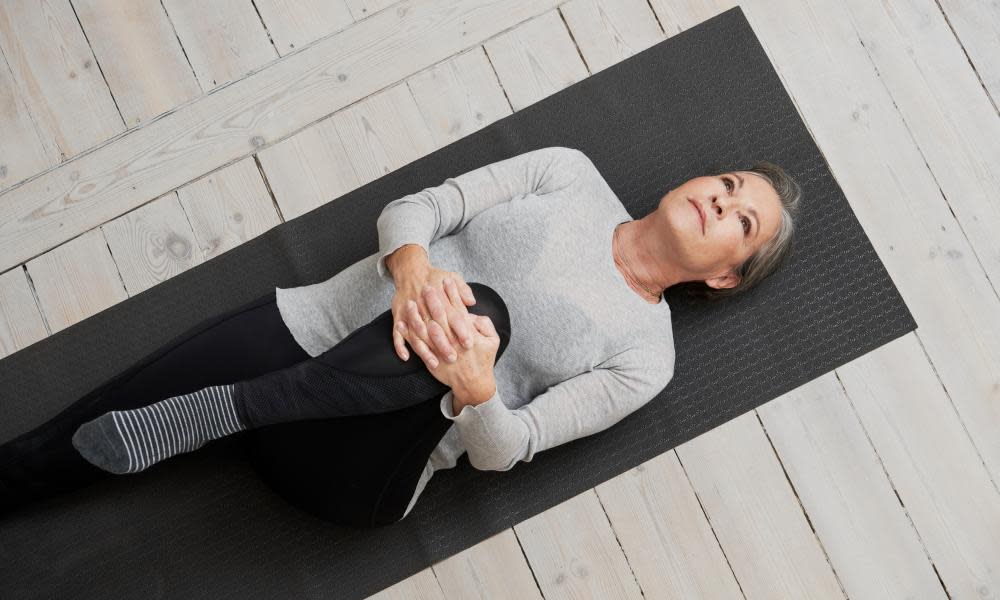How to move: exercising with chronic fatigue syndrome

Exercise is not appropriate for everyone living with CFS but if it works for you, here is a beginner’s guide to doing so safely
Chronic fatigue syndrome (CFS) is a disorder characterised by extreme fatigue that can’t be fully explained by any other medical condition.
Research suggests exercise may have a positive effect on fatigue in people with CFS but the evidence is limited, and even small amounts of exertion can lead to post-exertional malaise. Sarah Comensoli, an exercise physiologist, says it’s counterintuitive to start exercising if you know there’s a risk it will lead to malaise.
Exercise isn’t a cure, Comensoli says, but it can help build function and strength, and improve sleep and energy levels. “We don’t focus on taking all the pain away, but we keep the focus on function,” she says. “Exercise can help people do more.”
Related: How to move: exercising with fibromyalgia
Inactivity makes the body even less able to handle exertion and can exacerbate other symptoms, such as pain and stiffness. But Andrew Fitzgerald, a musculoskeletal and sports physiotherapist, says everyone has different limits when it comes to exercise, and it is crucial for people with CFS to be aware of theirs. For some people exercise might not be recommended.
Here is a simple guide to exercising when living with CFS. It is always advised to seek advice from a physiotherapist or doctor before you begin an exercise program. Exercise can make the disease much worse if not done appropriately.
The class: pilates
Pilates-based conditioning exercises offer a gentle, complete body workout that is adaptable to various levels of fitness and may be beneficial for people with CFS. It combines stretching and strengthening floor exercises aiming at toning the whole body through controlled and precise movements.
Pilates exercises focus on strengthening core muscles, which can help support the rest of the body. A strong core can ease the strain on the back and limbs, potentially resulting in less fatigue.
Pilates may not be the place to start for those who have not been active for a while. But for those who already have a certain level of mobility and low levels of stiffness, pilates can improve strength and overall fitness.
The move: leg press
“Reclined or recumbent exercises are generally a good place to start for someone with chronic fatigue,” says Melissa Williams, an integrative physiotherapist.
Floor-based strength exercises can counteract the de-conditioning of muscles that occurs when individuals go through prolonged periods without exercise.
A simple version of the leg press is one exercise that can help strengthen the lower body.
Begin by lying on your back with knees bent at 90 degrees and your feet in the air. Place a resistance band under the arches of your feet, holding the ends of the band in your hands, and regulate the tension by moving your hands towards or away from your armpits.
Bring your knees towards your chest without lifting your hips off the ground and then push your legs away from you, against the resistance band, as far as it feels comfortable. Then bring your knees back to your chest.
Related: How to move: exercising after having Covid-19
You can further modify the exercise by extending one leg at a time or eliminating the resistance band.
Strengthening major muscles, such as the leg muscles, may improve mechanical efficiency when carrying out daily activities. But when performing resistance exercises such as the leg press, it is strongly recommended not to reach exhaustion because that may exacerbate fatigue.
“[Exercise] is about making sure someone can function in their day to day tasks, before worrying about doing anything too technical or hardcore,” Comensoli says.
The activity: walking
The energy demands of walking can be significantly greater for people with CFS compared with other people. But regular walks, even if for only a few minutes, may help people with CFS get moving in a manageable way.
Wearing a pedometer and a heart rate monitor can help you measure how far – and at what intensity – you can walk before you reach a state of fatigue. That can help you establish the level of activity that you can bear without suffering any adverse effects or post-exertional malaise.
The hard pass: high-intensity activity
“High intensity or endurance type activities, such as long-distance running, are not recommended,” Fitzgerald says.
“It’s not to say that those things are indefinitely off the table,” Williams says. “But having a program tailored to how your body is responding is important.”
Williams says progress is not always gradual nor linear, and rest plays a crucial role in CFS management.
“Some CFS sufferers feel like they need to push through in order to get better or to progress,” she says.
“Our advice to people is to listen to their body and follow what it’s telling them to do.”


